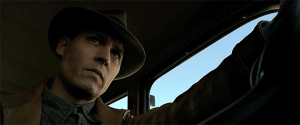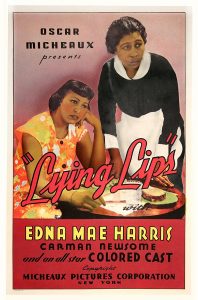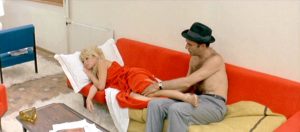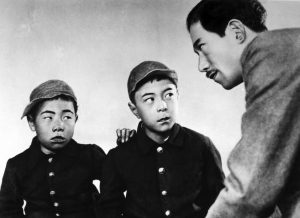PUBLIC ENEMIES
Michael Mann (U.S. 2009) 160 min. DCP. With Christian Bale, Johnny Depp, Christian Stolte.
Mann takes the possibilities of digital moviemaking to breathtaking new heights in this white-hot gangster saga about a federal lawman (Bale)’s pursuit of notorious bank robber John Dillinger (a devastatingly cool Depp). Moody, hyper-real imagery, and a painstaking recreation of Depression-era America, Public Enemies is Dillinger’s short, violent ride with his lover (Marion Cotillard) to nowhere. Comic book pulp elevated to visual poetry. (BAMcinématek Program Notes)
TOP OF PAGE
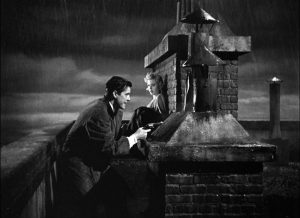
Monday, January 30 at 7pm
MINISTRY OF FEAR
Fritz Lang (U.S. 1944) 86 min. 35MM. With Ray Milland, Marjorie Reynolds, Carl Esmond.
Critic Dave Kehr called Ministry of Fear “the epochal meeting of two masters of Catholic guilt and paranoia,” the masters being director Fritz Lang and Graham Greene, whose dizzying story of feints and false leads he was adapting. While Greene scorned the adaption, and Lang himself was soured by the unyielding control over the script wielded by producer-writer Seton Miller, from its very first image of a closely-watched clock, Ministry of Fear winds through an unmistakably Langean maze of seances, phony suicides and blind men who can see. Ray Milland’s nervous and enigmatic protagonist proves especially susceptible to random twists of fate in this anti-Nazi thriller, a fitting overture to the increasingly pervasive threat permeating the Lang’s post-war films. (Adapted from Harvard Film Archive Program Notes)
Monday, February 6 at 7pm
LYING LIPS
Oscar Micheaux (U.S. 1939) 80 min. With Edna Mae Harris, Carman Newsome, Robert Earl Jones.
One of the last films by the major force of independent black cinema in the first half of the twentieth century, Micheaux’s Lying Lips is a crime melodrama featuring Robert Earl Jones (father of James Earl Jones) as a police detective and Micheaux regular Edna Mae Harris as a nightclub singer sent to prison for the murder of her aunt. It is also, as the title suggests, in scholar Ron Green’s words, “a negative-image movie, a litany of weaknesses. In addition to the lying, the viewer is regaled with exploitative pandering, prostitution, habitual sexual promiscuity, illegitimate paternity, coerced marriage through faked pregnancy, superficial religiosity, male dependency on women in the forms of matriarchal bullying and financial payoff, chronic and acute domestic violence, murder, lack of discipline, lack of trust, inability to defer gratification, alcoholism, superstition, conspiracy, grand larceny, and the framing of an innocent person. It is no wonder that many in the black community were upset with Micheaux’s films.”
PUBLIC HOUSING
Frederick Wiseman (U.S. 1997) 195 min.
Documenting daily life at the Ida B. Wells public housing development in Chicago, Wiseman’s intimate portrait records the experiences of people living in conditions of extreme poverty: street life, teenage mothers and dysfunctional families; elderly residents and nursery school; drug education, afterschool and job training programs; and the efforts of the tenants council. Also given screen time is the essential, bureaucratic and troubled work of the city, state and federal governments maintaining and changing the institution of public housing.
“In Public Housing, [Wiseman] has a superabundance of articulate, dramatic, stressed-out subjects. Wherever he points the camera, there is another confrontation between the lower-class, black inhabitants of the projects and the middle-class, mostly black professionals who are there to serve them, help them get on their feet, and, incidentally, police them… Again and again one is made to feel the distance between problems and solutions.” – Philip Lopate, Film Comment
TOP OF PAGE
Monday, February 20 at 7pm 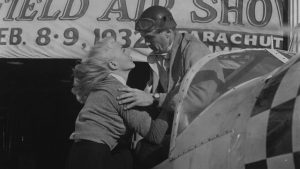
THE TARNISHED ANGELS
Douglas Sirk (U.S. 1957) 91 min. 35MM. With Rock Hudson, Robert Stack, Dorothy Malone, Jack Carson.
The great German director Rainer Werner Fassbinder famously said that “Sirk has made the tenderest films I know; they are the films of someone who loves people and doesn’t despise them as we do.” In The Tarnished Angels – which features the same leads as Sirk’s celebrated Written on the Wind (1956) and is adapted from William Faulkner’s Pylon – the tormented souls the director loves are a WWI pilot now performing daredevil tricks in air-shows (Stack), his parachute jumper wife (Malone), their devoted mechanic (Carson) and the alcoholic journalist drawn into their unhappy lives (Hudson). “Sirk looks at these corpses with such tenderness and radiance that we start to think that something must be at fault if these people are so screwed up and, nevertheless, so nice. The fault lies with fear and loneliness. I have rarely felt fear and loneliness so much as in this film” (R.W. Fassbinder).
TOP OF PAGE
Monday, February 27 at 7pm
CONTEMPT – Digital Restoration
Jean-Luc Godard (France 1963) 103 min. DCP. With Brigitte Bardot, Michel Piccoli, Jack Palance. French with English subtitles.
Godard’s foray into commercial filmmaking is a Cinemascope epic about marital breakdown and artistic compromise that overturns conventions of mainstream filmmaking and critiques post-Hollywood movies even while working with a star-studded cast and the biggest budget of his career. Michel Piccoli is a screenwriter trying to doctor the script for an adaptation of The Odyssey, a man torn between the demands of his disillusioned wife (Bardot), a European director (played by the legendary director Fritz Lang, representing the argument for art as cinema) and a crude, arrogant American producer (Palance, cinema as commerce). The remarkable final shot has Godard himself as the Director of Photography, turning the camera to the audience, as if to ask: “which side are you on?”
“Splendid, prophetic, visually ravishing… This pop-art masterpiece is still light years ahead of its time.” – J. Hoberman
TOP OF PAGE
Monday, March 6 at 7pm
I WAS BORN, BUT…
Yasujiro Ozu (Japan 1932) 100 min. 35MM. With Tatsuo Saito, Mitsuko Yoshikawa, Hideo Sugawara. Silent with English subtitles.
One of Ozu’s most popular films, I Was Born, But . . . is a blithe portrait of the financial and psychological toils of one family, as told from the rascally point of view of a couple of stubborn little boys. For two brothers, the daily struggles of bullies and mean teachers is nothing next to the mortification they feel when they realize their good-natured father’s low-rung social status. Reworked decades later as Ozu’s Technicolor comedy Good Morning, I Was Born, But… is a poignant evocation of the tumult of childhood, and also a showcase for Ozu’s expertly timed comedy editing.
TOP OF PAGE
Monday, March 20 at 7pm 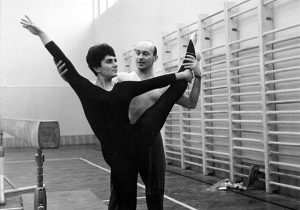
SOMETHING DIFFERENT
Věra Chytilová (Czechoslovakia 1963) 85 min. With Eva Bosáková and Věra Uzelacová.
One of the Czech New Wave’s most irreverent and boundary-breaking talents, Věra Chytilová made films that rebelliously and humorously critiqued the expectations and strictures of female gender roles in her society, proffering blistering attacks on patriarchy. After working as a fashion model and film production clapper girl, Chytilová attended FAMU, Prague’s renowned film school. Something Different, her debut feature, follows two women: one strand of the film is a documentary following an Olympic gold-medallist gymnast in gruelling training, the second is the fictional story of a discontented housewife.
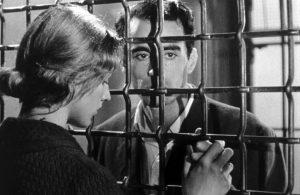
TOP OF PAGE
Monday, March 27 at 7pm
PICKPOCKET
Robert Bresson (France 1959) 75 min. 35MM. With Martin Lasalle, Marika Green, Pierre Leymarie. French with English subtitles.
This incomparable story of crime and redemption from the French master Robert Bresson follows Michel, a young pickpocket who spends his days working the streets, subway cars and train stations of Paris. As his compulsive pursuit of the thrill of stealing grows, however, so does his fear that his luck is about to run out. A cornerstone of the career of this most economical and profoundly spiritual of filmmakers, Pickpocket is an elegantly crafted, tautly choreographed study of humanity in all its mischief and grace, the work of a director at the height of his powers.
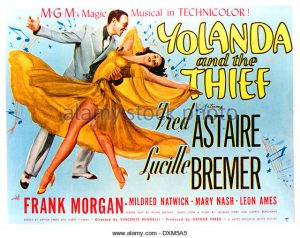
TOP OF PAGE
Monday, April 3 at 7pm
YOLANDA AND THE THIEF
Vincente Minnelli (U.S. 1945) 108 min. 35MM. With Fred Astaire, Lucille Bremer, Frank Morgan, Mildred Natwick.
The story of an heiress and the swindler who pretends to be her guardian angel, Yolanda and the Thief is a fairy tale told in surreal Technicolor. The film’s art direction and choreography were inspired by Tiepolo, Miró, and Tanguy, yet it is fundamentally the vision of “Vincente Minnelli, a superb pictorialist as well as a great director, [who] let his imagination run wild, and the result is a captivating, dreamlike film composed of startling, outrageous, and sometimes sublime images. It has nothing to do with good taste—and that may be the secret of its peculiar appeal. It’s kitsch liberated, personalized, and intensified, to the point where taste drops out and the film becomes an act of crazy artistic courage” (Dave Kehr).
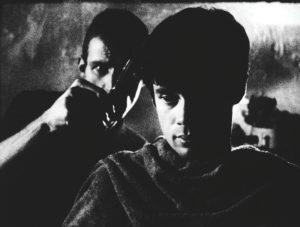
TOP OF PAGE
Monday, April 10 at 7pm
HAIRCUT (NO.1) & CAMP
Andy Warhol (U.S. 1963/1965) 27 min./ 66 min. 16MM.
Among the several hundred 16mm films made by the cunningly sincere, Pop provocateur Andy Warhol, were three “Haircut” films, inspired by photographer Billy Name’s haircutting parties (held in his apartment on the lower east side of Manhattan), and made before Warhol settled on the fixed-frame long-take style. These have since been numbered by the Whitney Museum of Art as part of their Andy Warhol Project. Haircut (No. 1) features John Daley, Freddy Herko, Billy Name and James Waring. In Camp’s variety show, Gerard Malanga is the Master of Ceremonies, introducing performances by Factory regulars such as Paul Swan, Jack Smith and Mario Montez.
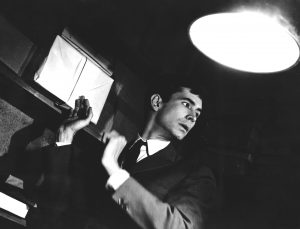
TOP OF PAGE
Monday, April 17 at 7pm
THE TRIAL – Digital Restoration!
Orson Welles (France/West Germany/Italy 1962, 119 min. With Anthony Perkins, Jeanne Moreau, Romy Schneider, Orson Welles.
Welles’ view of Franz Kafka’s posthumous classic of meaningless persecution changes the ending and rearranges the plot, but remains faithful to the
incidents, while stylistically attaining some of the most baroque effects of the great director’s career. A uniquely personal work (he dubbed 11 of the characters himself), this was Welles’ first film since Citizen Kane to be released as the director intended.
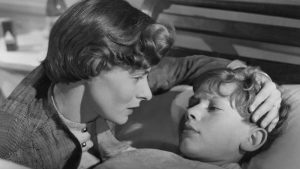 TOP OF PAGE
TOP OF PAGEMonday, April 24 at 7pm
EUROPE ’51
Roberto Rossellini (Italy 1952) 109 min. DCP. With Ingrid Bergman, Alexander Knox, Ettore Giannini, Giulietta Masina.
Ingrid Bergman plays a wealthy, self-absorbed Rome socialite racked by guilt over the shocking death of her young son. As a way of dealing with her grief and finding meaning in her life, she devotes her time and money to the city’s poor and sick, with a single-minded activism that leads to conflicts with her husband and questions about her sanity. The intense, often overlooked Europe ’51 was, according to Rossellini, a retelling of his own The Flowers of St. Francis, from a female perspective. This unabashedly political but sensitively conducted investigation of modern sainthood was the director’s favorite of his films.
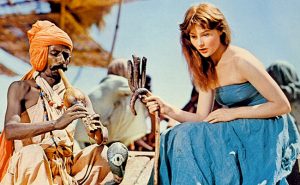
TOP OF PAGE
Monday, May 1 at 8pm
Please note film will begin later than the usual time to allow for a 6:30pm showcase of recent Bucknell student films.
THE RIVER
Jean Renoir (France 1951) 99 min. 35MM. With Patricia Walters, Radha, Adrienne Corri, Nora Swinburne.
The greatest of Renoir’s late-period films and arguably one of the greatest color films ever made, The River takes its story from Rumer Godden’s book about two children growing up in Bengal, India in the waning years of British colonialism. Into this framework Renoir finds the perfect expression for his lyrical humanism among an expat community and three young women who are stirred by the arrival of a wounded American war veteran. For his first foray into color, Renoir left Hollywood, journeyed to India, met Satyajit Ray, and disregarded the advice of the film’s financiers—who told him a movie set in India “must have certain essential elements: tigers, Bengal lancers and elephants.” Instead, Renoir recalled, “India brought me a certain understanding of life. . . . India may have taught me that everyone has his reasons.” Renoir’s nephew Claude, a longtime collaborator, provided The River’s stunning Technicolor cinematography.
